Click on images to enlarge
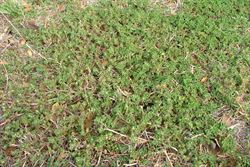
infestation (Photo: Sheldon Navie)

habit (Photo: Sheldon Navie)
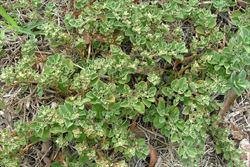
habit (Photo: Sheldon Navie)
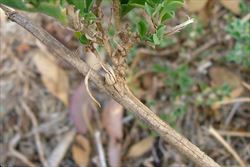
older woody stem (Photo: Sheldon Navie)

leaves (Photo: Sheldon Navie)
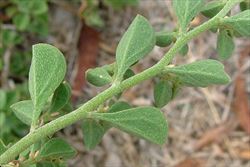
close-up of younger stem and leaf undersides showing tiny close-lying hairs (Photo: Sheldon Navie)

pinkish flowers (Photo: Sheldon Navie)

whitish flowers (Photo: Sheldon Navie)

close-up of whitish flower (Photo: Greg Jordan)
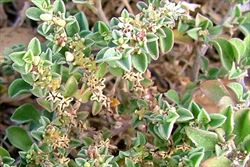
immature and mature fruit (Photo: Sheldon Navie)

Galenia secunda, a much more hairy plant with yellow flowers (Photo: Sheldon Navie)
Scientific Name
Galenia pubescens (Eckl. & Zeyh.) Druce var. pubescens
Synonyms
Aizoon pubescens Eckl. & Zeyh.
Galenia secunda (L. f.) Sond. (misapplied)
Family
Aizoaceae
Common Names
blanket weed, carpet weed, carpetweed, coastal galenia, galenia
Origin
Native to southern Africa (i.e. Cape Province, Orange Free State and Transvaal in South Africa).
Naturalised Distribution
Widely naturalised in the southern regions of Australia, and also scattered in other parts of the country. It is relatively common in Victoria, south-eastern South Australia, south-western Western Australia and in some parts of central New South Wales. Also recorded in other parts of South Australia, the southern parts of the Northern Territory, Tasmania and northern Queensland.
Naturalised overseas in south-western USA (i.e. California).
Habitat
This species has become naturalised mainly in temperate regions, but is also present in semi-arid and sub-tropical environments. It is a weed of highly disturbed sites (e.g. mine sites), waste areas, coastal environs, roadsides, parks, footpaths and lawns.
Habit
A long-lived (i.e. perennial), creeping (i.e. prostrate) herbaceous plant that usually forms a dense mat of vegetation over the ground.
Distinguishing Features
- a long-lived creeping plant usually forming a dense mat of vegetation on the ground.
- its thick stems are covered in small white hairs and become somewhat woody in as they mature.
- its small alternately arranged leaves (3-35 mm long and 2-22 mm wide) are also loosely covered in small white hairs.
- its inconspicuous flowers (4-6 mm across) have five small white or pinkish 'petals' and are borne singly in the leaf forks.
- its small capsules (about 3 mm long) contain a few shiny black seeds.
Stems and Leaves
The creeping (i.e. prostrate) stems of this species (up to 1 m long) are relatively thick for their size and older stems are somewhat woody in nature. Younger stems are greyish-green in colour and loosely covered in small white hairs (i.e. they are appressed pubescent).
Both sides of the leaves are also loosely covered in short white hairs (i.e. they are appressed pubescent), giving the plant a greyish appearance. These leaves are relatively small (3-35 mm long and 2-22 mm wide) and either egg-shaped in outline (i.e. ovate) or somewhat spoon-shaped (i.e. spathulate). They have entire margins and are alternately arranged along the stems, though they are often quite crowded near the tips of the branches.
Flowers and Fruit
The inconspicuous flowers (about 4-6 mm across) are almost stalkless (i.e. sub-sessile) and are borne singly in the leaf forks (i.e. axils). These flowers have five small (2-3 mm long) white, greenish-white or pinkish coloured 'petals' (i.e. perianth segments or tepals) that may turn yellowish as they mature. They also have ten stamens and an ovary topped with five tiny styles. Flowering occurs mostly during summer (i.e. from October to April).
The fruit are small capsules (2.5-3 mm long and about 1 mm wide) and usually contain five shiny black seeds (about 1 mm long). These seeds are kidney-shaped (i.e. reniform) and covered in numerous tiny bumps (i.e. they are tuberculate).
Reproduction and Dispersal
This species reproduces mostly by seed. The seeds may be dispersed by water, animals, machinery (e.g. mowers) and in dumped garden waste or lawn clippings. In pasture areas, coastal galenia (Galenia pubescens var. pubescens ) may also be spread by livestock that ingest its seeds.
Environmental Impact
Coastal galenia (Galenia pubescens var. pubescens) is regarded as an environmental weed in Victoria, South Australia and Western Australia. This species is known to grow over and smother existing ground layer vegetation and, due to its low-growing and spreading habit, it also prevents the germination of native species.
Coastal galenia (Galenia pubescens var. pubescens) is a common environmental weed of the Adelaide region, and the wider Gulf St. Vincent area, in South Australia. It prefers sandy soils and disturbed sites, and is especially problematic in coastal areas. For example, is one of the most extensive and difficult to eradicate weeds species found in the dune system of the Henley South and West Beach Dune Reserve. It has also been recorded in other conservation areas in this state (e.g. in Onkaparinga River National Park, Moana Sands Conservation Park, Cobbler Creek Recreation Park and Hallett Cove Conservation Park).
In Victoria, coastal galenia (Galenia pubescens var. pubescens) seems to be spreading rapidly. It is currently causing concern in some areas on the northern and western outskirts of Melbourne, where it has invaded conservation areas (i.e. in the Kananook Creek area and in Yarra Bend Park). It is also listed as being highly invasive in native grasslands in the South Gippsland Plains bioregion and is beginning to invade threatened rocky chenopod open-scrub communities in disturbed and relatively undisturbed sections of the Long Forest Nature Conservation Reserve.
In Western Australia, coastal galenia (Galenia pubescens var. pubescens) is naturalised in highly disturbed sites and occasionally on beach seepages between Geraldton and Albany. In New South Wales, where it is not yet very widespread, this species is often locally abundant around mining areas. It is already reported to be causing environmental problems in this state. A population of river red gum (Eucalyptus camaldulensis) in the Hunter catchment was recently given an endangered population listing by the NSW Scientific Committee, because regeneration of trees is not occurring in most remnants. Infestation of the understorey by weed species, including coastal galenia (Galenia pubescens var. pubescens), is one of the reasons that this regeneration is not occurring.
Other Impacts
Coastal galenia (Galenia pubescens var. pubescens) also invades pastures. However, it is generally found in areas where over-grazing has occurred.
Legislation
This species is declared under legislation in the following states and territories:
- New South Wales: Class 4 - a locally controlled weed. The growth and spread of this species must be controlled according to the measures specified in a management plan published by the local control authority and the plant may not be sold, propagated or knowingly distributed (in the Liverpool Plains and Tamworth Regional local authority areas).
- Western Australia: Unassessed - this species is declared in other states or territories and is prohibited until assessed via a weed risk assessment (throughout the entire state).
Management
For information on the management of this species see the following resources:
- the New South Wales Department of Industries Noxious and Environmental Weed Control Handbook, which is available online at http://www.dpi.nsw.gov.au.
Similar Species
Coastal galenia (Galenia pubescens var. pubescens) can be easily confused with galenia (Galenia secunda) and the native berry saltbush (Atriplex semibaccata), as these plants all form mats of vegetation on the ground. They may be distinguished by the following differences:
- coastal galenia (Galenia pubescens var. pubescens) has flowers with five small white or pinkish 'petals' and five styles. Its fruit are small dry capsules and its leaves have entire margins.
- galenia (Galenia secunda) has flowers with five small white or yellowish 'petals' and four styles. Its fruit are small dry capsules and its leaves have entire margins.
- berry saltbush (Atriplex semibaccata) has separate male and female flowers that do not have any petals. Its fruit are small fleshy red berries (up to 5mm long) and its leaves usually have toothed margins.

